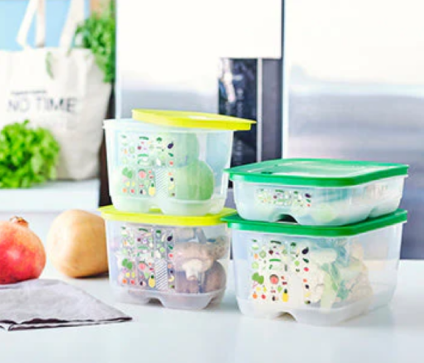
History
History
Tupperware emerges as a testament to the fusion of ingenuity and strategic marketing.
Founded in the 1940s by the visionary Earl S. Tupper, a chemist by trade, our legacy commenced with the introduction of the "Miracle Bowl" in 1946. Crafted from polyethylene, this airtight and watertight marvel not only transformed food storage but elevated the preservation of flavor, aroma, and nutritional value. Yet, it was the marketing brilliance of Brownie Wise that catapulted Tupperware into the global phenomenon we proudly represent today.
1940s
A Revolutionary Beginning
In the 1940s, the inception of Tupperware marked a culinary revolution. Earl S. Tupper unveiled the "Miracle Bowl," a polyethylene marvel that redefined food storage. Its airtight seal preserved taste, aroma, and nutrients, setting a new standard for kitchenware.This breakthrough was nothing short of a culinary game-changer, as households everywhere embraced the concept of extended food freshness. Tupperware's arrival signaled a shift in how families approached food preservation and meal planning.

1950s
Brownie Wise and the Tupperparty® Phenomenon
The 1950s witnessed the ascension of Brownie Wise, a marketing visionary. She pioneered the Tupperparty®, transforming how Tupperware was presented. These intimate gatherings allowed customers to experience products firsthand, forging personal connections and driving sales. Through Brownie Wise's ingenuity, Tupperware transcended mere containers; it became an interactive experience, an opportunity for households to enhance their kitchen routines.The Tupperparty® phenomenon breathed life into Tupperware, giving it a vibrant, social dimension that revolutionized the way people thought about kitchenware.

1960s
Global Expansion and Household Domination
In the swinging 60s, Tupperware's influence went global. It became a staple in households across Europe, Central, and South America. Its quality and convenience made it an integral part of kitchens worldwide. As Tupperware crossed borders, it brought with it a promise of freshness and innovation.The iconic brand became a household name, gracing kitchen shelves from London to Buenos Aires, leaving an indelible mark on how households approached food storage and meal preparation.

1970s
Colorful Catalogs and Household Essentials
The 1970s brought a burst of color and innovation. Tupperware catalogs showcased a diverse range of kitchen essentials. From the Jel-Ring Mold to the Pick-A-Deli Container, these products found their way into homes, solidifying Tupperware's presence.The era was marked by a colorful kaleidoscope of choices, reflecting the brand's commitment to providing practical, yet stylish, solutions for modern households. Tupperware's presence in homes became synonymous with vibrant, organized, and efficient kitchens.

1980s
Reusability Takes Center Stage
The 1980s heralded a focus on reusability. Tupperware introduced items like the Sandwich Keeper and Lunch ‘N Bag sets. Additionally, kid-friendly products like stencils and the Tupper Canoe were introduced, appealing to families. It was an era where Tupperware not only catered to the culinary needs of households but also recognized the importance of sustainable, reusable solutions.The introduction of family-friendly products further cemented Tupperware's role as an essential part of households.

1990s
FridgeSmart® and Pioneering Freshness
Collaborating with the University of Florida, Tupperware introduced FridgeSmart® containers in the 90s. This innovative solution extended the freshness of fruits, vegetables, and herbs, becoming a household staple.The 90s marked a pivotal moment in Tupperware's journey, as it addressed a pressing concern in households worldwide: how to keep produce fresher for longer. FridgeSmart® containers revolutionized the way families stored their perishables, making it a household essential.

2000s
Culinary Innovation and Convenience
The 2000s saw Tupperware's expansion into cookware. Products like the MandoChef series, Microwave Pressure Cooker, and spiralizers revolutionized meal preparation, providing both innovation and convenience. As the culinary landscape evolved, Tupperware didn't just keep pace; it led the way.The introduction of cookware innovations catered to the ever-changing needs of modern kitchens, further establishing Tupperware as a trusted companion in meal preparation.

2010s
Sustainability, Space Farming, and Design Recognition
Partnering with SABIC, Tupperware used circular material made from mixed plastic waste, launching the “No Time to Waste” sustainability campaign. In Europe, where eco-consciousness runs deep, this initiative found a particularly receptive audience.Tupperware also developed and patented PONDS, a device for growing vegetables in space, in collaboration with Redwire Space and NASA. The brand was honored in Fast Company’s Innovation by Design Awards.

2020s
Sustainability, Entertainment, and Innovation: Tupperware's Multi-Faceted Journey
Tupperware committed to a multi-year agreement with the National Park Foundation for the Resilience & Sustainability Initiative. In Europe, where natural beauty is cherished, this partnership resonated strongly. The brand played prominent roles in Amazon Prime’s The Marvelous Mrs. Maisel and Universal’s Minions: The Rise of Gru, captivating European audiences.Tupperware partnered with TerraCycle for their zero-waste circularity platform, Loop, aligning with the sustainability values held dear in Europe. The ECO+ line expanded with a partnership with materials company, Eastman, offering even more sustainable options for European households.
